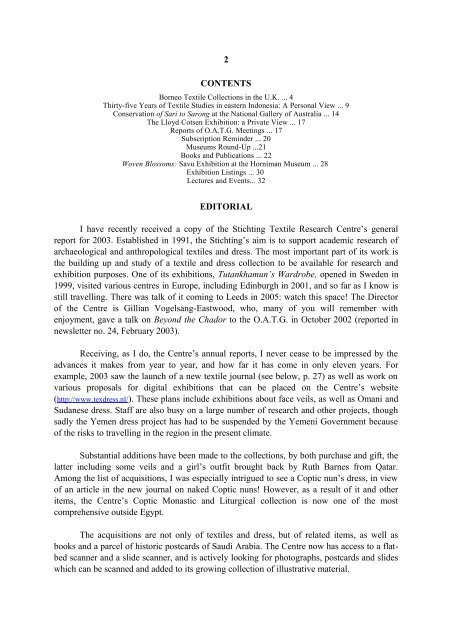download - OATG. Oxford Asian Textile Group
download - OATG. Oxford Asian Textile Group
download - OATG. Oxford Asian Textile Group
You also want an ePaper? Increase the reach of your titles
YUMPU automatically turns print PDFs into web optimized ePapers that Google loves.
2<br />
CONTENTS<br />
Borneo <strong>Textile</strong> Collections in the U.K. ... 4<br />
Thirty-five Years of <strong>Textile</strong> Studies in eastern Indonesia: A Personal View ... 9<br />
Conservation of Sari to Sarong at the National Gallery of Australia ... 14<br />
The Lloyd Cotsen Exhibition: a Private View ... 17<br />
Reports of O.A.T.G. Meetings ... 17<br />
Subscription Reminder ... 20<br />
Museums Round-Up ...21<br />
Books and Publications ... 22<br />
Woven Blossoms: Savu Exhibition at the Horniman Museum ... 28<br />
Exhibition Listings ... 30<br />
Lectures and Events... 32<br />
EDITORIAL<br />
I have recently received a copy of the Stichting <strong>Textile</strong> Research Centre’s general<br />
report for 2003. Established in 1991, the Stichting’s aim is to support academic research of<br />
archaeological and anthropological textiles and dress. The most important part of its work is<br />
the building up and study of a textile and dress collection to be available for research and<br />
exhibition purposes. One of its exhibitions, Tutankhamun’s Wardrobe, opened in Sweden in<br />
1999, visited various centres in Europe, including Edinburgh in 2001, and so far as I know is<br />
still travelling. There was talk of it coming to Leeds in 2005: watch this space! The Director<br />
of the Centre is Gillian Vogelsang-Eastwood, who, many of you will remember with<br />
enjoyment, gave a talk on Beyond the Chador to the O.A.T.G. in October 2002 (reported in<br />
newsletter no. 24, February 2003).<br />
Receiving, as I do, the Centre’s annual reports, I never cease to be impressed by the<br />
advances it makes from year to year, and how far it has come in only eleven years. For<br />
example, 2003 saw the launch of a new textile journal (see below, p. 27) as well as work on<br />
various proposals for digital exhibitions that can be placed on the Centre’s website<br />
(http://www.texdress.nl/). These plans include exhibitions about face veils, as well as Omani and<br />
Sudanese dress. Staff are also busy on a large number of research and other projects, though<br />
sadly the Yemen dress project has had to be suspended by the Yemeni Government because<br />
of the risks to travelling in the region in the present climate.<br />
Substantial additions have been made to the collections, by both purchase and gift, the<br />
latter including some veils and a girl’s outfit brought back by Ruth Barnes from Qatar.<br />
Among the list of acquisitions, I was especially intrigued to see a Coptic nun’s dress, in view<br />
of an article in the new journal on naked Coptic nuns! However, as a result of it and other<br />
items, the Centre’s Coptic Monastic and Liturgical collection is now one of the most<br />
comprehensive outside Egypt.<br />
The acquisitions are not only of textiles and dress, but of related items, as well as<br />
books and a parcel of historic postcards of Saudi Arabia. The Centre now has access to a flatbed<br />
scanner and a slide scanner, and is actively looking for photographs, postcards and slides<br />
which can be scanned and added to its growing collection of illustrative material.
















